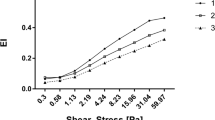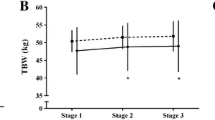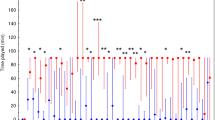Summary
Short-course ‘sprint’ triathlons have become popular in recent years, often as a precursor to the longer full-course triathlons. We undertook a study investigating the haematological and biochemical changes that occur in novice triathletes between the start and finish and after each of the three legs of a short sprint triathlon involving swimming, cycling and running. The changes that occurred in the triathlon included a significant (P<0.003) decrease in weight from 71.7 kg, SD 7.9 to 70.3 kg, SD 7.6. Throughout the time span of the triathlon, the white blood cell count increased significantly (P<0.001), as did the platelet count (P<0.005) and plateletcrit (P<0.001). There were no significant changes during the period of the race in any of the other haematological variables measured. The biochemical variables measured were glucose, triglycerides, sodium, potassium, calcium, lactate dehydrogenase, creatinine and aspartate aminotransferase. Triglyceride, calcium and potassium values did not change between the pre- and post-race samplings. All other biochemical parameters showed a significant change (P<0.05 or better). Changes that occurred in the haematological and biochemical parameters between stages were many and varied. There was also a significant change in plasma volume during the swimming event (P< 0.001), but this returned to normal during the later stages of the triathlon. In conclusion the changes that occurred during the triathlon were many and were similar to those reported elsewhere in the literature for longer events. The novice triathletes who participated, found this short triathlon to be as stressful as the full-course triathlon is for the more experienced athlete. We feel, however, that this type of event is useful as a precursor to the longer type of events.
Similar content being viewed by others
References
Ahlborg G, Felig P (1982) Lactate and glucose exchange across the forearms, legs and splanchnic bed during and after prolonged leg exercise. J Clin Invest 69:45–49
Carlson LA, Mossfeldt F (1964) Acute effects of prolonged heavy exercise on the concentration of plasma lipids and lipoproteins in man. Acta Physiol Scand 62:51–59
Cohen I, Zimmerman AL (1978) Changes in serum electrolyte levels during marathon running. S Afr Med J 53:449–453
Costill DL (1984) Energy supply in endurance activities. Int J Sports Med [Suppl] 5:19–21
Critz JB, Cunningham DA (1972) Plasma enzyme levels in man after different physical activities. J Sports Med Phys Fitness 12:143–149
Dancaster CP, Whereat SJ (1971) Fluid and electrolyte balance during the Comrades Marathon. S Afr Med J 45:147–150
Davidson RJL, Robertson JD, Maughan RJ (1986) Haematological changes due to triathlon competition. Br J Sports Med 20:159–161
Davidson RJL, Robertson JD, Galea G, Maughan RJ (1987) Hematological changes associated with marathon running. Int J Sports Med 8:19–25
Dill DB, Costill DL (1974) Calculation of percentage changes in volumes of blood, plasma and red cells in dehydration. J Appl Physiol 37:247–248
Editorial (1985) ‘Anemia’ in athletes. Lancet II:1490–1491
Essen B (1977) Intramuscular substrate utilization during prolonged exercise. Ann NY Acad Sci 301:30–44
Essen B, Hagenfeldt L, Kaijser L (1977) Utilization of blood borne and intramuscular substrates during continuous and intermittent exercise in man. J Physiol (Lond) 265:489–506
Felig P, Wahren J (1975) Fuel homeostasis in exercise. N Engl J Med 293:1078–1082
Finch SC (1977) Granulocytosis. In: Williams WJ, Beutler E, Erslev AJ, Rundles WR (eds), Hematology. McGraw Hill Books, New York, pp 746–755
Fowler WM, Gardner GW, Kazerunian HH, Lauvstad WA (1968) The effect of exercise on serum enzymes. Ach Phys Med Rehabil 49:554–556
Galea G, Davidson RJL (1985) Haemorheology of marathon running. Int J Sports Med 6:136–138
Galun E, Burstein R, Assia E, Tur-Kaspa I, Rosenblum J, Epstein Y (1987) Changes of white blood cell count during prolonged exercise. Int J Sports Med 8:253–255
Hagan RD, Diaz FJ, Horvath SM (1978) Plasma volume changes with movement to supine and standing positions. J Appl Physiol 45:414–418
Hallberg L, Magnusson B (1984) The aetiology of ‘sports anaemia’. Editorial. Acta Med Scand 216:145–148
Henry RJ, Cannon DC, Winkelman JW (1974) Clinical chemistry principles and techniques, 2nd edn. Harper and Row, New York, pp 873–884
Holly RG, Barnard RJ, Rosenthal M,Applegate E, Pritikin N (1986) Triathlete characterization and response to prolonged strenuous competition. Med Sci Sports Exerc 18:123–127
Hytten FE, Paintin DB (1963) Increase in plasma volume during normal pregnancy. J Obstet Gynaecol Br Commonw 73:181–190
Imelik O (1981) The changes in the concentration and total amount of the electrolytes in the blood serum at various muscular exercises. In: Poortmans J and Nist G (eds) Biochemistry of exercise IV-A. University Park Press, Baltimore, pp 550–556
Jedrzejezak WW, Sulek K, Siekierzynski M (1979) Mobilization of the marginal pool of neutrophils with epinephrine. Haematologia (Budap) 64:586–596
Jooste PL, Linde A van der, Shapiro CM, Stryden NB (1981) Metabolism of ultra-long distance running. In: Poortmans J, Nist G (eds) Biochemistry of exercise IV-A. University Park Press, Baltimore, pp 93–99
Kelly JC, Godlonton JD (1980) The 1980 Comrades Marathon. S Afr Med J 58:509–510
Keppel G (1982) Design and analysis: a researcher's handbook (2nd ed.). Prentice Hall, Englewood Cliffs, New Jersey
Kielblock AJ, Majoo M, Booyens J, Katzeff IE (1979) Creatinine phosphokinase and lactate dehydrogenase levels after ultralong distance running. S Afr Med J 55:1061–1064
Kohrt WM, Morgan DW, Bates B, Skinner JS (1987) Physiological responses of triathletes to maximal swimming, cycling and running. Med Sci Sports Exerc 19:51–55
Korge P, Viru A (1971) Water and electrolyte metabolism in skeletal muscle of exercising rats. J Appl Physiol 31:1–4
Krebs PS, Scully BC, Zinkgraft SA (1983) The acute and prolonged effects of marathon running on 20 m blood parameters. Physician Sportsmed 11:66–73
Magazanik A, Shapiro Y, Mejtes D, Meyteo I (1974) Enzyme blood levels and water balance during a marathon race. J Appl Physiol 36:214–217
Maron MB, Horvath SM (1978) The marathon: a history and review of the literature. Med Sci Sports 10:137–150
Maron MB, Horvath SB, Wilkerson JE (1975) Acute blood biochemical alterations in response to marathon running. Eur J Appl Physiol 34:173–181
McArdle WD, Katch FI, Katch VL (1986) Exercise physiology, energy nutrition and human performance. Lea and Febiger, Philadelphia, pp 39–48
McKechnie JK, Leary WP, Noakes TD (1982) Metabolic responses to a 90 km running race. S Afr Med J 66:482–484
Mc Naughton LR (1989) Plasma volume responses associated with a sprint triathlon in novice triathletes. Int J Sports Med 10:161–164
Noakes TD, Carter JW (1976) Biochemical parameters in athletes before and after having run 160 kilometres. S Afr Med J 50:1562–1566
Olivier LR, Woal A de, Refief FJ (1978) Electrocardiographic and biochemical studies on marathon runners. S Afr Med J 53:783–787
O'Toole ML, Hiller WDB, Crosby LO, Douglas PS (1987) The ultraendurance triathlete: a physiological profile. Med Sci Sports Exerc 19:45–60
Rensburg JP van, Kielblock AJ, Walt WH van der (1984) Maximal aerobic capacity and endurance fitness as determinants of rowing, cycling and running performance during a triathlon competition. Aust J Sci Med Sport 16:12–16
Rensburg JP van, Kielblock AJ, Linde A van der (1986) Physiologic and biochemical changes during a triathlon competition. Int J Sports Med 7:30–35
Rose LI, Boussei JR, Cooper KH (1970) Serum enzymes after marathon running. J Applied Physiol 29:355–357
Scheele K, Herzog W, Ritthaler G, Wirth A, Weicker H (1979) Metabolic adaptations to prolonged exercise. Eur J Appl Physiol 41:101–108
Schmidt KG, Rasmusson JW (1984) Exercise induced changed in the vivo distribution of In-labelled platelets. Scand J Haematol 32:159–166
Senay LC, Rogers G, Jooste P (1980) Changes in blood plasma during progressive treadmill and cycle exercise. J Appl Physiol 49:59–65
Sreter FA, Friedman SM (1963) Distribution of water, sodium and potassium in resting and stimulated mammalian muscle. Can J Biochem 41:1035–1045
Taunton JE, McKenzie DC, Clement DB, Cook GJ (1986) Physiological and metabolic changes associated with the ultramarathon. In: Dotson CO, Humphrey JH (eds) Exercise physiology current selected research, vol 2. AMS Press, New York, pp 49–60
Tietz NW (1987) Fundamentals of clinical chemistry, 3rd edn. Saunders, Philadelphia, pp 369–373
Whiting PH, Maughan RJ, Miller JDB (1984) Dehydration and serum biochemical changes in marathon runners. Eur J Appl Physiol 52:183–187
Williams MH (1983) Nutrition for fitness and sport. Williams C. Brown, Dubuque, Iowa, pp 131–206
Wyndham CH, Kew MC, Kok R, Bersohn I, Strydom NB (1974) Serum enzyme changes in unacclimatized and acclimatized men under severe heat stress. J Appl Physiol 35:695–698
Author information
Authors and Affiliations
Rights and permissions
About this article
Cite this article
Long, D., Blake, M., Naughton, L.M. et al. Hematological and biochemical changes during a short triathlon competition in novice triathletes. Eur J Appl Physiol 61, 93–99 (1990). https://doi.org/10.1007/BF00236700
Accepted:
Issue Date:
DOI: https://doi.org/10.1007/BF00236700




